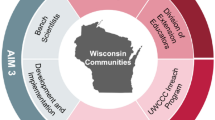Abstract
Engaging partners in the planning, implementation, and evaluation of cancer education programs is critical for improving the health of our communities. A 2-year pilot education intervention on prostate cancer decision making and participation in medical research was funded by the National Cancer Institute. The partnership involving community members and clinical staff at a cancer center was used to develop recruitment strategies and plan for the implementation of the intervention with African-American middle-age and older men and female family members. We assessed partners’ perceptions of this community–academic–clinical research collaboration. In year 2, eight project advisory council members were selected among existing partners and year 1 participants to serve as a formal committee. Council members were required to participate in telephone and in person meetings and actively support recruitment/implementation efforts. At the conclusion of the project, 20 individuals (all clinical and community partners, including the eight advisory council members) were invited to complete a survey to assess their perceived impact of the collaboration on the community and provide suggestions for future collaborations. Most partners agreed that their organization benefitted from the collaboration and that various aspects of the advisory council process (e.g., both formal and informal communication) worked well. The most noted accomplishment of the partnership related to leveraging the collaboration to make men more knowledgeable about prostate cancer decision making. Suggested improvements for future collaborations included distributing more frequent updates regarding project successes. Evaluating partners’ perceptions of this collaboration provided important recommendations for future planning, implementation, and evaluation of community-based cancer education programs.
Similar content being viewed by others
References
Freedman DA, Choi SK, Hurley T, Anadu E, Hebert JR (2013) A farmers’ market at a federally qualified health center improves fruit and vegetable intake among low-income diabetics. Prev Med 56:288–292
Freedman DA, Whiteside YO, Brandt HM, Young V, Friedman DB, Hebert JR (2012) Assessing readiness for establishing a farmers’ market at a community health center. J Community Health 37:80–88
Friedman DB, Johnson KM, Owens OL et al (2012) Developing partnerships and recruiting dyads for a prostate cancer informed decision making program: lessons learned from a community-academic-clinical team. J Cancer Educ 27:243–249
Friedman DB, Young VM, Freedman DA et al (2012) Reducing cancer disparities through innovative partnerships: a collaboration of the South Carolina Cancer Prevention and Control Research Network and Federally Qualified Health Centers. J Cancer Educ 27:59–61
Hebert JR, Brandt HM, Armstead CA, Adams SA, Steck SE (2009) Interdisciplinary, translational, and community-based participatory research: finding a common language to improve cancer research. Cancer Epidemiol Biomarkers Prev 18:1213–1217
Thomas TL, Owens OL, Friedman DB, Torres ME, Hebert JR (2012) Written and spoken narratives about health and cancer decision making: a novel application of photovoice. Health Promot Pract. doi:10.1177/1524839912465749
Minkler M, Vasquez VB, Tajik M, Petersen D (2008) Promoting environmental justice through community-based participatory research: the role of community and partnership capacity. Health Educ Behav 35:119–137
Parker DF, Dietz NA, Hooper MW et al (2012) Developing an urban community-campus partnership: lessons learned in infrastructure development and communication. Prog Community Health Partnersh 6:435–441
Rubin CL, Martinez LS, Chu J et al (2012) Community-engaged pedagogy: a strengths-based approach to involving diverse stakeholders in research partnerships. Prog Community Health Partnersh 6:481–490
Sadler LS, Larson J, Bouregy S et al (2012) Community-university partnerships in community-based research. Prog Community Health Partnersh 6:463–469
Owens OL, Jackson DD, Thomas TL, Friedman DB, Hebert JR (2013) African-American men’s and women’s perceptions of clinical trials research: focusing on prostate cancer among a high risk population in the South. J Health Care Poor Underserved 24(4):1784–1800
Friedman DB, Thomas TL, Owens OL, Hebert JR (2012) It takes two to talk about prostate cancer: a qualitative assessment of African-American men’s and women’s cancer communication practices and recommendations. Am J Mens Health 6(6):472–484
Strauss A, Corbin J (1998) Basics of qualitative research: techniques and procedures for developing grounded theory. Sage Publications, Thousand Oaks
Mattessich P, Murray-Close M, Monsey B (2001) Wilder collaboration factors inventory. Wilder Research, Paul, MN
Varda DM. PARTNER Tool. 2010. Accessed October 15, 2012, at http://www.partnertool.net/
Bell-Elkins J Assessing the CCPH Principles of Partnership in a Community-Campus Partnership. 2002. Accessed January 15, 2013, at http://depts.washington.edu/ccph/pdf_files/friendly%20principles2.pdf
Acknowledgments
Funded by the National Cancer Institute (NCI) Community Networks Program Centers U54 CA153461 (PI: Hébert; Pilot Project Leader: Friedman). Partially supported by an Established Investigator Award in Cancer Prevention and Control from the Cancer Training Branch of the NCI to J.R. Hébert (K05 CA136975). We gratefully acknowledge Dr. Dan B. Fried, MD, Dr. Drew Monitto, MD, Renee Romberger, Sharon Bartelt, Sonya Lovett, DeLisa Dawkins, Dawn Skaggs, Bruce Grant, Noel Kinnard, Tracey Thomas, Andre McCullough, Joyce Wallace, Nancy Waddell, Jacqueline Talley, the advisory council, partners, and study participants.
Author information
Authors and Affiliations
Corresponding author
Rights and permissions
About this article
Cite this article
Friedman, D.B., Owens, O.L., Jackson, D.D. et al. An Evaluation of a Community–Academic–Clinical Partnership to Reduce Prostate Cancer Disparities in the South. J Canc Educ 29, 80–85 (2014). https://doi.org/10.1007/s13187-013-0550-5
Published:
Issue Date:
DOI: https://doi.org/10.1007/s13187-013-0550-5




